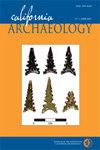The Mystery of the Plate of Brass: California’s Greatest Hoax and the Search for its Perpetrators
IF 0.7
0 ARCHAEOLOGY
引用次数: 0
Abstract
This book tells the story of the plate of brass found in Marin County, California, in the 1930s and for decades widely thought to be a relic of Francis Drake’s sixteenth-century visit. Technical analyses during the 1970s, however, showed the artifact to be a modern fake. But who made it, and for what purpose, and why was “California’s greatest hoax” not detected sooner? These are among the queries answered by the authors, based upon research by The Drake Navigators Guild (DNG; a group of historians and mariners who study Drake’s 1577– 1580 voyage) and James Spitze. Nautical historian and DNG President Edward Von der Porten had nearly finished the manuscript when he died unexpectedly in 2018; his son, Michael, then saw to its publication. When Francis Drake boldly sailed through the Strait of Magellan and up the west coast of South America in 1579, he left in his wake looted Spanish ships and towns along with hostile mariners and colonists who deemed him a pirate. In fact, Drake was a privateer whose circumnavigation of the globe had been secretly sponsored by Queen Elizabeth and other English investors. This is why, before leaving the California harbor where he careened and re-provisioned his ship, Golden Hind, Drake affixed to a post an engraved brass plate declaring that the local (indigenous) “king and people” had freely relinquished their province to Her Majesty. Drake called this province Nova Albion (Albion being the old Roman name for England). Thus, in 1579 Drake laid claim on behalf of Elizabeth to America’s first New England, six years before English settlers arrived at Roanoke Island and 28 years before Jamestown was occupied. In 1936, Beryle Shinn found a rectangular plate of brass, inscribed and signed “... FRANCIS DRAKE”, at Greenbrae on the northwest shore of San Francisco Bay. This find was announced in April 1937 by Herbert Bolton, an eminent professor of history at the University of California, Berkeley (UCB). Soon afterwards, William Caldeira came forward to say that he had found the very same plate in 1933 near Drakes Bay and later discarded it at Greenbrae. Bolton judged the plate authentic, and metallurgical testing in 1937–1938 seemed confirmatory. Although some scholars expressed doubts, and rumors of a hoax were bruited, the general consensus over the next few decades was that the plate of brass was genuine. Its “discovery” fueled controversy as to where Drake had landed and was used by some to support a San Francisco Bay location. Meanwhile, in March 1937, the president of the California Historical Society (CHS) purchased the plate from Shinn for $3,500 and donated it to UCB.《铜板之谜:加州最大的骗局及对肇事者的搜寻
这本书讲述了20世纪30年代在加利福尼亚州马林县发现的黄铜板的故事,几十年来,人们普遍认为这是弗朗西斯·德雷克16世纪访问的遗物。然而,20世纪70年代的技术分析表明,这是一件现代赝品。但是是谁制造了它,出于什么目的,为什么“加州最大的骗局”没有早点被发现?这些都是作者根据德雷克航海家协会(the Drake Navigators Guild, DNG)的研究回答的问题。(一群研究德雷克1577 - 1580年航行的历史学家和水手)和詹姆斯·斯皮策。航海历史学家、DNG总裁爱德华·冯·德·波特在2018年意外去世时,几乎完成了手稿;他的儿子迈克尔(Michael)负责出版这本书。1579年,当弗朗西斯·德雷克(Francis Drake)大胆地穿过麦哲伦海峡(Strait of Magellan),沿着南美西海岸航行时,他留下了被掠夺的西班牙船只和城镇,以及那些认为他是海盗的怀有敌意的水手和殖民者。事实上,德雷克是一艘私掠船,他的环球航行得到了伊丽莎白女王和其他英国投资者的秘密资助。这就是为什么,在离开加州港口之前,德雷克把他的船“金鹿号”(Golden Hind)倾斜并重新配置,他在一根柱子上贴了一块雕刻的铜板,宣布当地(土著)“国王和人民”已经自由地将他们的省交给女王陛下。德雷克称这个省为新阿尔比恩省(阿尔比恩是英格兰的古罗马名字)。因此,在1579年,德雷克代表伊丽莎白对美国的第一个新英格兰提出了主权要求,这比英国殖民者到达罗厄诺克岛早了六年,比詹姆斯敦被占领早了28年。1936年,贝里尔·希恩(Beryle Shinn)发现了一块长方形的黄铜板,上面刻有“……弗朗西斯·德雷克”,在旧金山湾西北岸的格林布雷。1937年4月,加州大学伯克利分校(UCB)著名的历史学教授赫伯特·博尔顿(Herbert Bolton)宣布了这一发现。不久之后,威廉·卡尔代拉(William Caldeira)出面说,他曾于1933年在德雷克斯湾(drake Bay)附近发现了一模一样的盘子,后来在格林布雷(Greenbrae)丢弃了它。博尔顿判断这块板是真的,1937年至1938年的冶金测试似乎也证实了这一点。尽管一些学者对此表示怀疑,并有谣言称这是一个骗局,但在接下来的几十年里,普遍的共识是黄铜板是真的。它的“发现”引发了关于德雷克降落地点的争议,并被一些人用来支持旧金山湾的地点。与此同时,1937年3月,加州历史学会(CHS)主席以3500美元的价格从希恩手中买下了这幅车牌,并捐赠给了加州大学洛杉矶分校。
本文章由计算机程序翻译,如有差异,请以英文原文为准。
求助全文
约1分钟内获得全文
求助全文

 求助内容:
求助内容: 应助结果提醒方式:
应助结果提醒方式:


